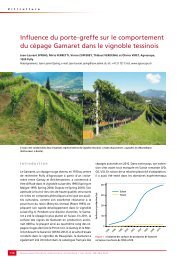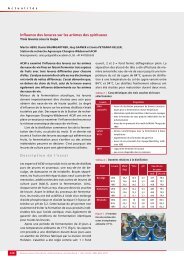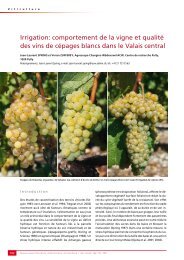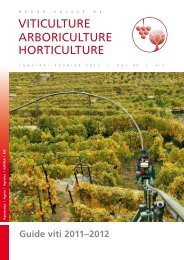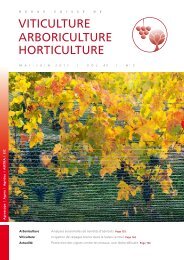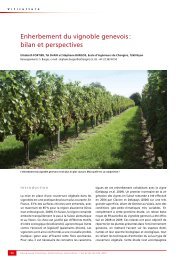Télécharger le PDF - Revue suisse de viticulture arboriculture ...
Télécharger le PDF - Revue suisse de viticulture arboriculture ...
Télécharger le PDF - Revue suisse de viticulture arboriculture ...
You also want an ePaper? Increase the reach of your titles
YUMPU automatically turns print PDFs into web optimized ePapers that Google loves.
Culture maraîchère | Economie d’énergie sous serre par intégration <strong>de</strong>s températures en culture <strong>de</strong> tomate sur substrat<br />
Summary<br />
Energy saving process un<strong>de</strong>r<br />
glasshouse by temperature<br />
integration over 24 hours in<br />
tomato culture on substrate<br />
Managing climate in the glasshouse<br />
by temperature integration<br />
(TI) over a 24-hour period<br />
is one of the ways to save energy.<br />
Three trials from 2006 to<br />
2008 in tomato crops on substrate<br />
showed that an energy<br />
saving potential of 15 to 30 % is<br />
possib<strong>le</strong> with TI compared to<br />
the standard temperature<br />
treatment. The annual yield<br />
was not influenced by TI in two<br />
of the three years. The TI reduced<br />
slightly the yield during<br />
the first cultivation period till<br />
mid-July. However, during the<br />
second period the yield was<br />
higher due to plant compensatory<br />
effects. In 2008 though,<br />
annual yield was penalised<br />
mainly due to prob<strong>le</strong>ms of pollination<br />
during the second cultivation<br />
period in the TI treatment.<br />
On the other hand, the<br />
temperature integration influenced<br />
neither the analytical<br />
quality of the fruits, nor the <strong>de</strong>velopment<br />
of pests, beneficial<br />
insects and diseases. The results<br />
confirm that temperature<br />
integration is a useful method<br />
to save energy. The conditions<br />
to respect in or<strong>de</strong>r to avoid<br />
yield reductions are discussed.<br />
Key words: temperature<br />
integration, tomato,<br />
glasshouse, energy saving.<br />
Zusammenfassung<br />
b Nieuwhof M., Keizer L. C. P. & Van Oeveren J. C., 1997. Effects of temperature<br />
on growth and <strong>de</strong>velopment of adult plant of genotypes of tomato<br />
(Lycopersicon escu<strong>le</strong>ntum Mill.). Journal of Genetics and Breeding 50,<br />
185 – 193.<br />
b Van <strong>de</strong>r Ploeg A. & Heuvelink E., 2005. Influence of sub-optimal temperature on<br />
tomato growth and yield: a review. Journal of horticultural Science & Biotechnology<br />
80 (6), 652 – 659.<br />
Energiesparmassnahmen<br />
im Gewächshaus mittels<br />
Temperaturintegration während<br />
24 Stun<strong>de</strong>n im Tomatenanbau<br />
auf Substrat<br />
Die Än<strong>de</strong>rung <strong>de</strong>r Klimaführung<br />
im Gewächshaus mittels<br />
Temperaturintegration (TI)<br />
während 24 Stun<strong>de</strong>n ist einer<br />
<strong>de</strong>r Wege, um Energie zu<br />
sparen. Drei Versuche von 2006<br />
bis 2008 im Tomatenanbau auf<br />
Substrat haben gezeigt, dass<br />
eine Energieeinsparung von 15<br />
bis 30 % möglich ist im Verg<strong>le</strong>ich<br />
zur klassischen Temperaturführung.<br />
In zwei von drei<br />
Versuchsjahren ist <strong>de</strong>r Jahresertrag<br />
durch die unterschiedliche<br />
Temperaturführung nicht<br />
beeinflusst wor<strong>de</strong>n. Die TI hat<br />
in <strong>de</strong>r ersten Kulturphase bis<br />
Mitte Juli <strong>de</strong>n Ertrag <strong>le</strong>icht<br />
reduziert. In <strong>de</strong>r zweiten Phase<br />
dagegen war <strong>de</strong>r Ertrag etwas<br />
höher aufgrund von kompensatorischen<br />
Effekten innerhalb<br />
<strong>de</strong>r Pflanze. Im 2008 war <strong>de</strong>r<br />
Jahresertrag im TI-Verfahren<br />
reduziert, vor al<strong>le</strong>m aufgrund<br />
von Befruchtungsprob<strong>le</strong>men in<br />
<strong>de</strong>r zweiten Kulturperio<strong>de</strong>. Die<br />
TI hat we<strong>de</strong>r die analytische<br />
Qualität <strong>de</strong>r Früchte, noch die<br />
Entwicklung von Schädlingen,<br />
Nützlingen und Krankheiten<br />
beeinflusst. Die Ergebnisse bestätigen,<br />
dass die Temperaturintegration<br />
eine nützliche<br />
Metho<strong>de</strong> ist, um Energie einzusparen.<br />
Massnahmen, die zu<br />
berücksichtigen sind, um Ertragsvermin<strong>de</strong>rungen<br />
zu vermei<strong>de</strong>n,<br />
wer<strong>de</strong>n diskutiert.<br />
130 <strong>Revue</strong> <strong>suisse</strong> Viticulture, Arboriculture, Horticulture | Vol 42 (2): 122–130, 2010<br />
Riassunto<br />
Risparmio energetico in serra<br />
per l'integrazione <strong>de</strong>l<strong>le</strong> temperature<br />
nella coltivazione di<br />
pomodori su substrato<br />
La modifica <strong>de</strong>lla gestione <strong>de</strong>l<br />
clima attraverso l’integrazione<br />
<strong>de</strong>l<strong>le</strong> temperature (IT) nell’arco<br />
<strong>de</strong>l<strong>le</strong> 24 ore è una <strong>de</strong>l<strong>le</strong> possibilità<br />
di risparmiare <strong>de</strong>ll’energia<br />
nel<strong>le</strong> colture serrico<strong>le</strong>. I tre anni<br />
di prova – dal 2006 al 2008 –<br />
nella coltivazione di pomodori<br />
su substrato, hanno dimostrato<br />
che è possibi<strong>le</strong> raggiungere un<br />
risparmio energetico <strong>de</strong>l<br />
15 % – 30 %. Tuttavia, la resa<br />
annua<strong>le</strong> non è stata, in due<br />
anni su tre, influenzata dal<strong>le</strong> diverse<br />
gestioni <strong>de</strong>l clima. L’IT ha<br />
<strong>le</strong>ggermente ridotto la resa<br />
nella prima fase di coltura, fino<br />
a metà luglio. Per contro, grazie<br />
a <strong>de</strong>i processi di compensazione<br />
<strong>de</strong>lla pianta, la resa è stata<br />
più e<strong>le</strong>vata nella seconda fase.<br />
Nel 2008 la resa <strong>de</strong>lla serra IT è<br />
stata penalizzata essenzialmente<br />
in seguito a <strong>de</strong>i prob<strong>le</strong>mi<br />
di al<strong>le</strong>gagione durante la seconda<br />
fase di coltivazione.<br />
D’altron<strong>de</strong>, l’integrazione <strong>de</strong>l<strong>le</strong><br />
temperature non ha avuto<br />
effetto né sulla qualità analitica<br />
<strong>de</strong>i frutti, né sullo sviluppo<br />
di parassiti, ausiliari e malattie.<br />
I risultati confermano che<br />
l’integrazione <strong>de</strong>l<strong>le</strong> temperature<br />
è un metodo uti<strong>le</strong> per risparmiare<br />
energia. Le condizioni<br />
da rispettare in modo da<br />
evitare diminuzioni di resa<br />
sono discusse.<br />
Remerciements<br />
Toute l’équipe du groupe culture sous serre <strong>de</strong> la Station <strong>de</strong> recherche Agroscope<br />
Changins-Wä<strong>de</strong>nswil ACW ainsi que <strong>le</strong>s stagiaires et apprentis qui ont participé à<br />
ces expérimentations sont remerciés pour <strong>le</strong>ur précieux travail.



